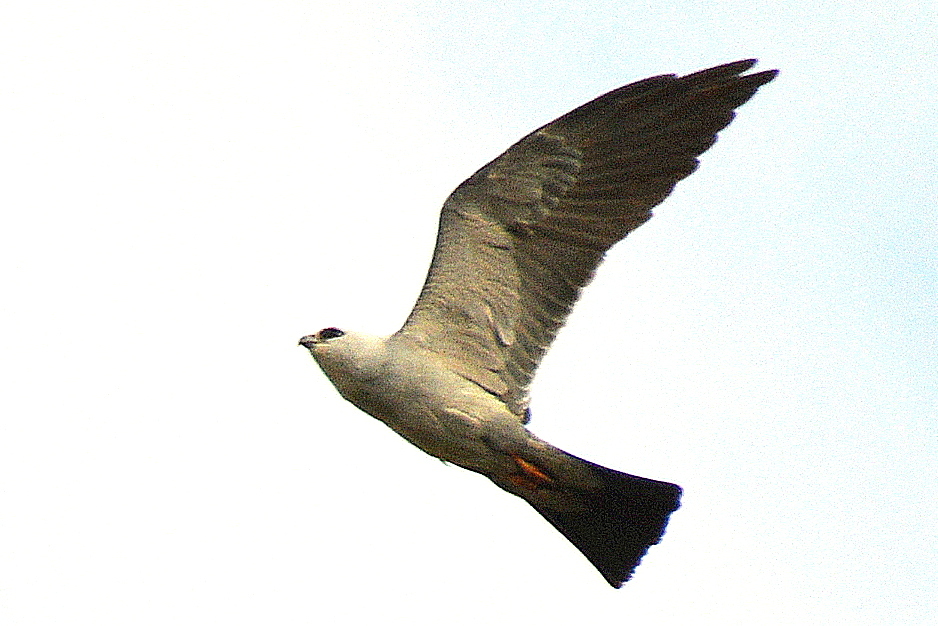
By Terry W. Johnson
If you were asked to prepare a list your backyard birds, it would undoubtedly include the brown thrasher, northern mockingbird, Carolina wren, northern cardinal, ruby-throated hummingbird and a host of other birds you regularly see in your yard.
Remarkably, in recent years some Georgians have been able to include the Mississippi kite on their lists.
Mississippi kites are one of the bird world’s most accomplished fliers. When airborne, these slender birds use their long, falcon-like wings and square tails to perform loops, circles and glides so spectacular they would make a barnstorming stunt plane pilot proud.
Those of us who are most likely to see Mississippi kites during spring and summer live in the southern half of Georgia. This is because this kite nests primarily from just north of the Fall Line southward across the Coastal Plain. Here, they nest mainly along the edges of expansive bottomland forests that hug large rivers such as the Ocmulgee, Altamaha, Oconee and Flint. They also nest in forested tracts along large pastures and agricultural fields.
However, over the past several decades they have begun nesting on golf courses, in parks and even in suburban neighborhoods and urban areas. Some of the cities known to play host to nesting Mississippis include Augusta, Macon, Dublin, Waycross and Savannah (there are more rare reports even from as far north as Athens). Georgians in these cities are starting to see the birds on a regular basis during summer.
Each of these municipalities has large, mature trees. While Mississippi kites will occasionally nest close to the ground, they prefer the high canopies of tall trees, often nesting 90 to 140 feet above the ground.
When the birds choose to nest in a backyard, residents can watch male and female kites build their flimsy nests out of sticks, moss, and leaves. They might even get to see the male feed the female during incubation. Once the young hatch, it is possible to watch both the male and female bring food to the young when they are very young. When the young are a little older, the adults will drop food items into the nest.
Mississippi kites are mainly insectivorous. Some of the critters they eat include cicadas, moths, beetles, katydids, grasshoppers and dragonflies. They will also snatch frogs, lizards, snakes, small mammals and birds. They capture most of these delicacies on the wing and with their feet. This raptor prefers to attack from above, swooping down to grab a dragonfly or other insect.
The birds often eat in flight, tearing apart their food and consuming it using both feet. These meals are accomplished without missing a wing beat.
At other times, the kites will hunt from a perch, dropping down to the ground and plucking a meal from a leaf or branch. They have also been known to run across the ground in pursuit of prey.
I know a Monroe County family that one summer enjoyed watching a nesting pair of Mississippi kites snagging cicadas flying across their yard. On one occasion, they saw a kite bring a small snake to the nest. Meanwhile in St. Marys, a backyard birder was left speechless when she witnessed a Mississippi kite snatch a hummingbird in midair as the bird flew away from one of her hummingbird feeders!
In times past, Mississippi kites would feed on insects flushed into the air by bison grazing across the vast prairies of the American West. Nowadays, the kites often follow livestock and mowing machines.
Recently my daughter had an encounter with a Mississippi kite that she will never forget. This took place in one of the most unlikely locations imaginable. She lives in a large subdivision in Columbia County just west of Augusta. It seems as she was mowing her front yard with a self-propelled mower on a recent July morning she noticed that she was flushing grasshoppers and dragonflies. Suddenly she realized the shadow of a large bird repeatedly coursing across her lawn.
Looking up she was surprised to see a Mississippi kite flying back and forth over her head. Although she often sees the kites gliding high above her yard, this bird was flying only 15 feet or so above her.
She later told me the bird was so close she was able to peer into its red eyes as well as see that its yellow talon-tipped toes were spread ready to capture prey. As she continued to mow, the bird eventually swooped down, grabbed a flying insect and flew off.
I am certain some people would be unnerved if they saw a bird roughly the size of a peregrine falcon flying so close to them. Such an experience might cause them to conjure up scenes from Alfred Hitchcock's classic horror film The Birds.
However, if you are lucky, maybe a pair of Mississippi kites will one day nest in your neighborhood. If they do, I promise it will elevate your backyard birding to new plateau and leave you with unforgettable memories.
Terry W. Johnson is a retired DNR program manager and executive director of TERN, the Wildlife Conservation Section’s friends group. Check out past columns, his Backyard Wildlife Connection blog and his book “A Journey of Discovery: Monroe County Outdoors.” His columns are also featured at DNR’s blog, under the Conservation tab. Permission is required to reprint a column.



















